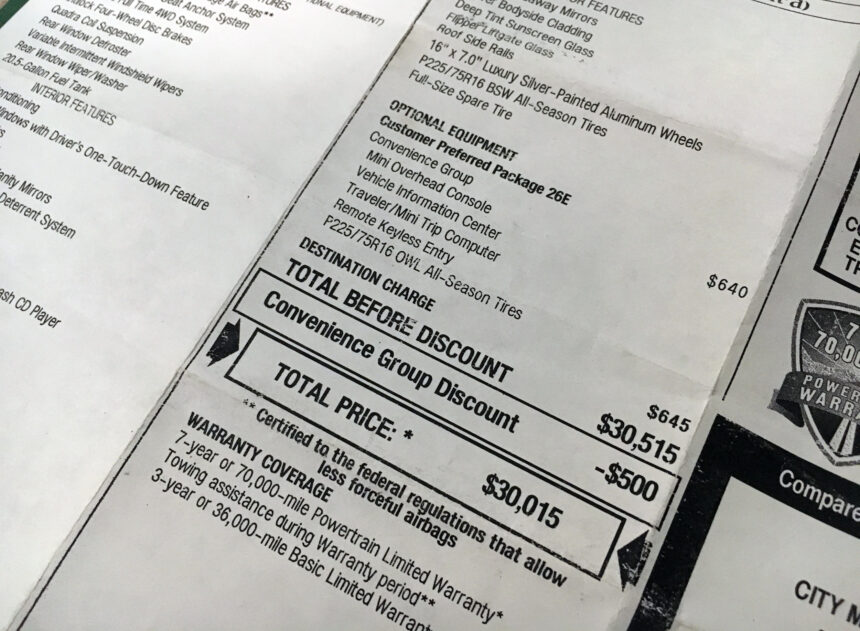The window sticker, also known as the Monroney label, is a crucial document that you will find on every showroom floor alongside new vehicles in the U.S. It serves as a standardized data sheet mandated for all new passenger vehicles weighing 10,000 pounds or less. This label is designed to provide essential information to consumers, such as vehicle equipment, safety ratings, fuel economy, parts origin, and the suggested retail price, without any marketing spin.
According to Alex Epstein, the director of Transportation Safety at the National Safety Council, the information on the Monroney label is verified by federal agencies like the EPA and NHTSA, ensuring consistency across all automakers. It acts as a valuable communication tool for consumers at the point of sale, helping them make informed decisions about the value of a new vehicle. Manufacturers are required to display this label, and any alterations or tampering can result in significant fines or even imprisonment.
The origin of the Monroney label can be traced back to the 1958 Automobile Information Disclosure Act, sponsored by Senator Almer Stillwell “Mike” Monroney of Oklahoma. The law mandated the inclusion of specific vehicle information on the sticker to prevent consumers from being deceived by car dealers. The label had to display details such as make, model, VIN, assembly point, dealer information, optional equipment, and total MSRP.
Over the years, the Monroney label has evolved to include more data that is beneficial to consumers. The addition of fuel economy information in the mid-70s was a significant step, driven by the Energy Policy and Conservation Act in response to the OPEC oil embargo. Subsequent regulations like the 1994 American Automobile Labeling Act required automakers to disclose the origin of parts and assembly, providing consumers with more transparency.
In 2007, the NHTSA introduced the five-star crashworthiness rating system on the Monroney label, giving consumers a quick reference for a vehicle’s safety performance. However, the agency does not crash-test all vehicles, highlighting a limitation in its mission. In 2013, the label underwent a major overhaul to include deeper efficiency data for alternative-fuel vehicles, reflecting the changing landscape of the automotive industry.
Fuel economy remains a crucial factor for consumers when making purchasing decisions. Studies have shown that consumers are willing to pay more for vehicles with better fuel efficiency, with the full presentation of EPA labeling influencing buyer behavior. The Monroney label continues to play a vital role in empowering consumers with the information they need to make informed choices when buying a new vehicle. Consumers who saw the full label on Monroney labels “were willing to pay significantly more for fuel economy compared to those who saw fuel economy information presented differently.” This finding highlights the importance of transparent and detailed information when it comes to making purchasing decisions, especially in the automotive industry.
The Monroney label, which has been a staple on new vehicles for decades, provides crucial information about a vehicle’s specifications, including fuel economy, pricing, and safety features. However, as technology continues to advance and vehicles become more complex, there is a growing need to update and expand the information provided on these labels.
Safety experts and analysts are calling for improvements to the Monroney label to better reflect the changing landscape of the automotive industry. With the rise of electric vehicles and the popularity of trucks, there is a need to include more information about advanced driver assistance systems (ADAS) and crash avoidance technologies on the label.
One example of this is the inclusion of star ratings for crash protection and crash avoidance systems. By providing consumers with clear and uniform information about a vehicle’s safety features, they can make more informed decisions about which car to purchase. This information can empower consumers and help them prioritize safety when choosing a vehicle.
The challenge lies in finding a balance between clarity and quantity of information on the Monroney label. With so many advanced technologies available in modern vehicles, it is important to present this information in a way that is easy to understand and digest. This is where organizations like the National Safety Council (NSC) and the University of Iowa’s Transportation and Vehicle Safety Research Program come in, developing resources like the “My Car Does What” website to help educate consumers about the latest automotive technologies.
Overall, the evolution of the Monroney label is crucial to keep up with the changing automotive landscape and ensure that consumers have access to the information they need to make informed decisions. By providing detailed and transparent information on fuel economy, safety features, and other key specifications, consumers can feel confident in their vehicle purchases and prioritize factors like fuel efficiency and safety when choosing a new car.







